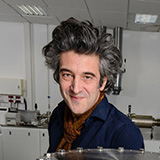séminaire – mercredi 25 novembre 2015
 Physiologie isotopique : le point de vue des métaux
Physiologie isotopique : le point de vue des métaux
Vincent Balter, Laboratoire de géologie, ENS Lyon
mercredi 25 novembre à 10 h 30, amphithéâtre Billet
The widespread hypoxic conditions of the tumor microenvironment can impair the metabolism of bioessential elements such as copper and sulfur, notably by changing their redox state and, as a consequence, their ability to bind specific molecules. Because competing redox state is known to drive isotopic fractionation, we have used here the stable isotope compositions of copper (65Cu/63Cu) and sulfur (34S/32S) in the blood of patients with hepatocellular carcinoma (HCC) as a tool to explore the cancer-driven copper and sulfur imbalances. We report that copper is 63Cu-enriched by ~0.4‰ and sulfur is 32S-enriched by ~1.5‰ in the blood of patients compared with that of control subjects. As expected, HCC patients have more copper in red blood cells and serum compared with control subjects. However, the isotopic signature of this blood extra copper burden is not in favor of a dietary origin but rather suggests a reallocation in the body of copper bound to cysteine-rich proteins such as metallothioneins. The magnitude of the sulfur isotope effect is similar in red blood cells and serum of HCC patients, implying that sulfur fractionation is systemic. The 32S-enrichment of sulfur in the blood of HCC patients is compatible with the notion that sulfur partly originates from tumor-derived sulfides. The measurement of natural variations of stable isotope compositions, using techniques developed in the field of Earth sciences, can provide newmeans to detect and quantify cancermetabolic changes and provide insights into underlying mechanisms.
- titre:
- Physiologie isotopique : le point de vue des métaux
- intervenant:
- Vincent Balter
- date:
- mercredi 25 novembre 2015
- kc_data:
- a:8:{i:0;s:0:"";s:4:"mode";s:0:"";s:3:"css";s:0:"";s:9:"max_width";s:0:"";s:7:"classes";s:0:"";s:9:"thumbnail";s:0:"";s:9:"collapsed";s:0:"";s:9:"optimized";s:0:"";}
- kc_raw_content:
 Physiologie isotopique : le point de vue des métaux
Physiologie isotopique : le point de vue des métauxVincent Balter, Laboratoire de géologie, ENS Lyon
mercredi 25 novembre à 10 h 30, amphithéâtre Billet
The widespread hypoxic conditions of the tumor microenvironment can impair the metabolism of bioessential elements such as copper and sulfur, notably by changing their redox state and, as a consequence, their ability to bind specific molecules. Because competing redox state is known to drive isotopic fractionation, we have used here the stable isotope compositions of copper (65Cu/63Cu) and sulfur (34S/32S) in the blood of patients with hepatocellular carcinoma (HCC) as a tool to explore the cancer-driven copper and sulfur imbalances. We report that copper is 63Cu-enriched by ~0.4‰ and sulfur is 32S-enriched by ~1.5‰ in the blood of patients compared with that of control subjects. As expected, HCC patients have more copper in red blood cells and serum compared with control subjects. However, the isotopic signature of this blood extra copper burden is not in favor of a dietary origin but rather suggests a reallocation in the body of copper bound to cysteine-rich proteins such as metallothioneins. The magnitude of the sulfur isotope effect is similar in red blood cells and serum of HCC patients, implying that sulfur fractionation is systemic. The 32S-enrichment of sulfur in the blood of HCC patients is compatible with the notion that sulfur partly originates from tumor-derived sulfides. The measurement of natural variations of stable isotope compositions, using techniques developed in the field of Earth sciences, can provide newmeans to detect and quantify cancermetabolic changes and provide insights into underlying mechanisms.
